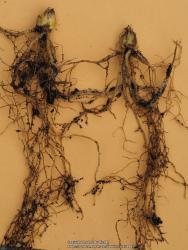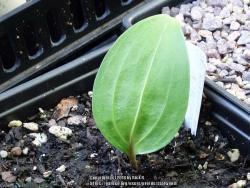Leftwood said:Della, very nice L. landifolium var. flaviflorum, and what a huge bonus to have both the maculatum and immaculatum forms!Very strong dark tepal edging on the petals that might be of hybridizing use.
I grew L. poilanei from seed , three of them to start, for a 3-4 years. Never made it to flower, but that was due to my own neglects: frying them by multiple accidental laps of watering, and finally, losing the pot in my menagerie, and it went through our Minnesota winter outside.The foliage pic below was taken a few days after a minus 4°C night, and they came through just fine, at least under the eave of my roof where the frost does not form on the leaves. So they are more cold tolerant than one might think. Overall, I found them to be quite resilient.
I did have two of them produce stems, but don't seem to have pics of that:

That's one good thing when you have lots of seed/plants to play with. You can learn a lot by trial and error.
I really don't know positively, but I wonder if L. poilanei really prefers a limy soil. Here in southern Minnesota, most of the base rock is limestone, and even on the limestone bluffs we have native acid loving plants growing right on top of the limestone. I think it really depends more on plant and soil flora that is present. When I grew it, poilanei was very happy in a bark based soil, pH adjusted to only slightly acid. Back then, I assumed that since it was allied with L. primulinum, it would prefer a neutral or acid soil. (I did also find, however, that bark based mixes are incredibly hungry for nitrogen due to the ongoing bark decomposition - another set back to growth.) In addition, are there any high rainfall areas with high pH soils? I don't think so. It might be partly because rain is naturally slightly acidic, but its buffering capacity is really low. No, I think it has more to do with chemical reactions inherent in such a climate and its natural floras.
My guess is that poilanei is just more pH tolerant than we think. Not that I would expect you to know, Della, but if you have a guess for the pH of the soil you created, do tell. I would be interested in what you do to create a limy soil. It has always been my contention that merely adding hydrated lime (the powdered stuff) to a soil mix will keep soil from getting too acid, but is too dangerous to use to produce a high pH. Reactions are too quick, and the correct amount to use is difficult to determine. It's easy to overdo. With my alpines that need a higher pH, I will add ad just a bit of hydrated lime, but also incorporate lots of crushed limestone of various sizes (1-5mm) to the mix for pH permanency.
I am going to assume the difficulty photographing the poilanei flowers stems from the light showing through the white tepals unevenly. That's always difficult for me, too, with flowers that don't have opaque enough color. Cloudy days with the most even light intensity all around seems to work best.
It seems all the lilies in the primulinum "clan" produce enormous amounts of pollen. Do make use of it....
I've tried it on everything with little success, but you will have other genetics that might be more compatible. For me, the only thing that may have taken is single seedling from L. davidii x (mixed Aurelian and L. majoense pollen) that in its third year is certainly growing into something that is that cross, and I still have majoense hopes. I know I took a pic of the potted plant last year, but heck if I can find it. So here it is in the one leaf stage and bulbs that are certainly not davidii that I planted out last fall.

The hardest lily to photograph has always been a martagon that is always the first to flower each season. Tried again this year - yuck.....
« Return to the thread "Pics of species?"
« Return to Lilies forum
« Return to the Garden.org homepage